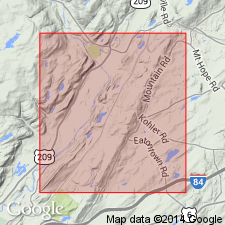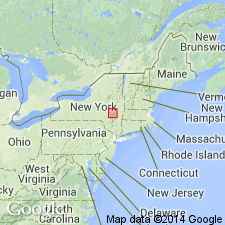
- Usage in publication:
-
- Guymard quartzite
- Modifications:
-
- Named
- Dominant lithology:
-
- Quartzite
- AAPG geologic province:
-
- Appalachian basin
Summary:
Named the Guymard quartzite for Guymard, near Otisville, Orange Co., NY. Name is attributed to a Professor van Ingen. Consists of over 100 ft of gray, olive, and reddish quartzite. The Guymard overlies the Shawangunk grit and underlies rocks characteristic of the Longwood shale. Unit is of Silurian age.
Source: GNU records (USGS DDS-6; Reston GNULEX).

- Usage in publication:
-
- Guymard†
- Modifications:
-
- Abandoned
- AAPG geologic province:
-
- Appalachian basin
Summary:
Rocks previously called Guymard Quartzite are considered to be the contact interval between the Shawangunk Formation and the Wurtsboro Tongue of the Bloomsburg Red Beds. The red bed within this interval is placed in the Shawangunk. Since these rocks can bed placed within the Shawangunk and Bloomsburg, the Guymard is abandoned.
Source: GNU records (USGS DDS-6; Reston GNULEX).
For more information, please contact Nancy Stamm, Geologic Names Committee Secretary.
Asterisk (*) indicates published by U.S. Geological Survey authors.
"No current usage" (†) implies that a name has been abandoned or has fallen into disuse. Former usage and, if known, replacement name given in parentheses ( ).
Slash (/) indicates name conflicts with nomenclatural guidelines (CSN, 1933; ACSN, 1961, 1970; NACSN, 1983, 2005, 2021). May be explained within brackets ([ ]).

